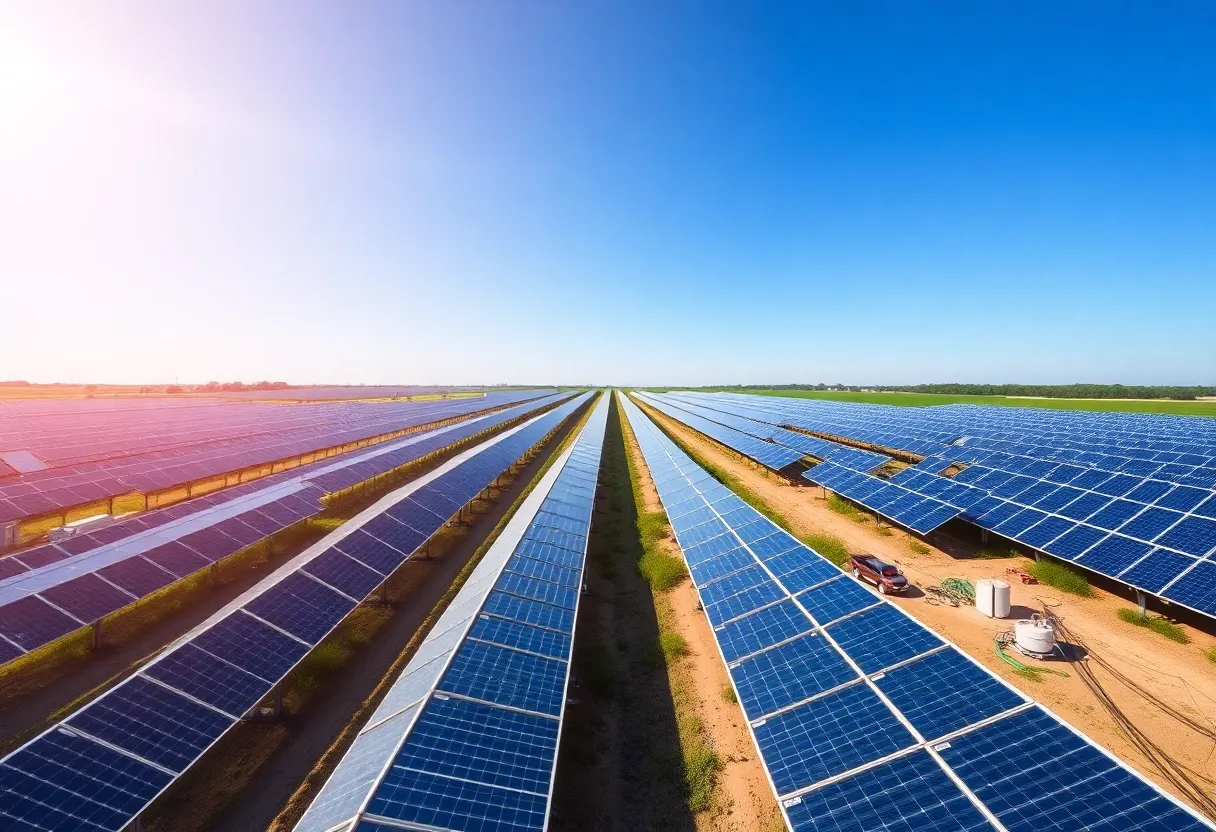Lawton, Oklahoma, October 6, 2025
SolarOkla, a local firm, has broken ground on a 50-megawatt solar farm in Lawton, Oklahoma, with $15 million in state support. The project aims to power 10,000 homes and reduce carbon emissions by 30,000 tons annually, contributing to Oklahoma’s goal of 20% clean energy by 2030. This initiative also promises job creation and economic benefits while advancing the state’s commitment to renewable energy.
Lawton, Oklahoma – SolarOkla Launches 50-MW Solar Farm with State Support
Lawton, Oklahoma, marked a significant advancement in renewable energy today as SolarOkla, a local firm focused on sustainable power solutions, broke ground on a new 50-megawatt solar farm. This project, supported by $15 million in state incentives, promises to generate clean electricity for approximately 10,000 homes and cut annual carbon emissions by 30,000 tons. Industry analysts view this development as a concrete move toward Oklahoma’s ambitious target of achieving 20% clean energy by 2030, highlighting the state’s growing commitment to environmental goals amid rising energy demands.
Project Details and Immediate Impacts
The solar farm, spanning a large site on the outskirts of Lawton, will utilize advanced photovoltaic panels to capture sunlight and convert it into usable electricity. Construction is set to span the next 18 months, with operations expected to begin in early 2027. Once fully operational, the facility will feed power directly into the regional grid, providing a reliable source of renewable energy to residential and commercial users in southwest Oklahoma. This initiative addresses the area’s increasing need for sustainable power, especially as population growth drives higher electricity consumption.
The $15 million in state incentives, drawn from funds allocated for green infrastructure, cover a portion of the project’s initial costs, including land preparation, panel installation, and grid integration. These funds help offset the upfront expenses typically associated with large-scale renewable projects, making them more feasible in regions like Oklahoma where traditional energy sources, such as natural gas and wind, have long dominated the market. By reducing reliance on fossil fuels, the solar farm is projected to lower energy costs over time for consumers through more stable pricing unaffected by volatile fuel markets.
Environmental and Economic Benefits
One of the standout features of this project is its environmental footprint. The anticipated reduction of 30,000 tons of carbon emissions each year equates to removing thousands of vehicles from the road, contributing to cleaner air and healthier communities in Lawton and surrounding areas. This aligns with broader national efforts to combat climate change, but at a local level, it supports Oklahoma’s push for diversified energy portfolios that balance economic growth with sustainability.
Economically, the solar farm is expected to create around 200 construction jobs over the build phase, with an additional 20 permanent positions for maintenance and operations once it’s online. Local suppliers in Lawton will benefit from contracts for materials and services, injecting vital revenue into the regional economy. As Oklahoma continues to invest in renewables, projects like this one demonstrate how green initiatives can stimulate job growth in rural areas, where opportunities are often limited compared to urban centers.
Broader Context in Oklahoma’s Energy Landscape
Oklahoma has traditionally been a powerhouse in energy production, thanks to its vast reserves of natural gas and established wind farms that already contribute significantly to the state’s power mix. However, the push toward renewables has accelerated in recent years, driven by federal incentives, technological advancements, and public demand for eco-friendly options. The state’s goal of reaching 20% clean energy by 2030 builds on existing progress, where wind power alone accounts for about 40% of electricity generation. Solar, though newer to the scene, offers complementary benefits, such as daytime peak production that pairs well with evening-heavy wind output.
This Lawton project is part of a wave of solar developments across Oklahoma, including smaller installations in the panhandle and central regions. Challenges remain, such as integrating intermittent solar power into the grid and securing long-term financing, but successes like this groundbreak signal momentum. For residents, the result will be more resilient energy infrastructure capable of withstanding extreme weather events, which have become more frequent in the region.
Future Outlook for Renewable Expansion
Looking ahead, experts anticipate that state incentives will continue to play a pivotal role in attracting firms like SolarOkla to Oklahoma. With solar technology costs dropping globally, the return on investment for such projects improves annually, encouraging private sector involvement. This farm not only boosts Lawton’s profile as a hub for clean energy but also sets a precedent for similar ventures statewide. As Oklahoma navigates its energy transition, balancing legacy industries with emerging renewables will be key to meeting the 2030 clean energy target while fostering sustainable development.
In summary, today’s groundbreaking represents a forward-thinking step for Lawton and Oklahoma, blending environmental stewardship with economic opportunity. The 50-megawatt facility underscores the viability of solar power in the Sooner State, paving the way for a greener future.
FAQ
What is the capacity of the new solar farm in Lawton?
The solar farm has a capacity of 50 megawatts.
How much state funding supports the SolarOkla project?
The project is backed by $15 million in state incentives.
How many homes will the solar farm power?
The project will power 10,000 homes.
What is the annual environmental impact of the solar farm?
The solar farm will reduce carbon emissions by 30,000 tons annually.
What is Oklahoma’s clean energy goal mentioned in relation to this project?
Experts hail it as a step toward Oklahoma’s goal of 20% clean energy by 2030.
Key Features Chart
| Feature | Details |
|---|---|
| Project Capacity | 50 megawatts |
| State Incentives | $15 million |
| Homes Powered | 10,000 homes |
| Annual Carbon Reduction | 30,000 tons |
| State Clean Energy Goal | 20% by 2030 |
Deeper Dive: News & Info About This Topic
HERE Resources
SolWind Energy Secures $15 Million Grant for Solar Farm in Oklahoma





